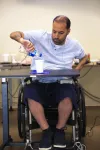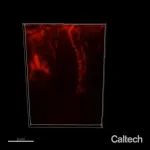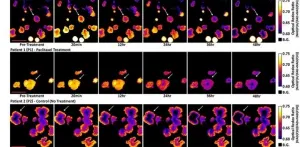(Press-News.org) RIVERSIDE, Calif. -- A University of California, Riverside, study analyzing fourth-generation electronic cigarette, or EC, pod atomizer design features has found the pod atomizers are similar to those of previous generations and contain elements that may adversely affect health and accumulate in the environment.
EC atomizers are chambers that hold nicotine-containing fluid and upon heating generate an aerosol. The pod-style e-cigarettes have become very popular, especially with young people.
The elements/metals in atomizers are important because chronic exposure could adversely affect human health. Further, EC pod products, which eventually enter the environment, could contribute to chemical pollution in water and soil.
"The more these devices aesthetically evolve, the more the atomizer components and elemental composition stay the same," said Esther Omaiye, a graduate student in Department of Molecular, Cell and Systems Biology at UC Riverside and the first author of the research paper that appeared in PLOS ONE. "While major components such as filaments, thick wires, filament-wire joints, air-tubes, and wicks have been preserved across generations, we see newer components in fourth-generation pod products such as connector pins, connector-wire joints, ceramic wicks and chambers that house these wicks."
"We set out to characterize the design features of pod-style atomizers and analyze the elemental composition of the atomizers," said Prue Talbot, a professor of cell biology at UCR, who led the research team. "These elements may, upon heating, enter the aerosol and be inhaled by users."
The external appearance, design, battery power, atomizers, and nicotine delivery of e-cigarettes have evolved over the last decade. Fourth-generation ECs or pods have low-powered batteries, an e-liquid reservoir, and an atomizer/mouthpiece. They contain high concentrations of nicotine and acid.
Scientists have only limited understanding of what exactly makes up EC pod atomizers, which are required components for aerosol production in e-cigarettes.
"Since elements in the atomizers can leach into the e-fluids or transfer to the aerosols when the e-fluids are heated, it is important to know what these elements are that users can get exposed to," said Omaiye, who works in Talbot's lab.
The researchers examined 11 fourth-generation EC pods from six brands/manufacturers. Of 23 elements they identified in the pod atomizers, 11 -- nickel, chromium, iron, gold, copper, zinc, tin, oxygen, silicon, carbon, and sodium -- were present in relatively high abundance. Some of these elements have been linked to human illnesses, including cardiovascular diseases, immune system suppression, lung injury, cancer, renal damage, neurotoxicity, and silicosis. Nickel, chromium, iron, and gold were found to be the most abundant elements in fourth-generation EC atomizers.
"We now know what elements users may be inhaling by using fourth-generation products," Omaiye said. "Our work reinforces the idea that e-cigarettes are not without harm. Our next line of research is evaluating fluids and aerosols generated from fourth-generation products to get a clearer picture of how their elements may be directly affecting e-cigarette users' health."
INFORMATION:
Talbot and Omaiye were joined in the research by UCR's Monique Williams and Krassimir N. Bozhilov. The research paper is titled "Design features and elemental/metal analysis of the atomizers in pod-style electronic cigarettes."
The University of California, Riverside (http://www.ucr.edu) is a doctoral research university, a living laboratory for groundbreaking exploration of issues critical to Inland Southern California, the state and communities around the world. Reflecting California's diverse culture, UCR's enrollment is more than 25,000 students. The campus opened a medical school in 2013 and has reached the heart of the Coachella Valley by way of the UCR Palm Desert Center. The campus has an annual statewide economic impact of almost $2 billion. To learn more, email news@ucr.edu.
Suppose you drop your morning coffee and it splatters everywhere. Later a colleague drops by to say hello. Do you grumble a testy acknowledgment, or cheerfully greet her?
In a new study on brain activity led by University of Miami psychologists, researchers found that how a person's brain evaluates fleeting negative stimuli--such as that dropped cup--may influence their long-term psychological well-being.
"One way to think about it is the longer your brain holds on to a negative event, or stimuli, the unhappier you report being," said Nikki Puccetti, a Ph.D. candidate in the Department of Psychology ...
East Hanover, NJ. March 22, 2021. Kessler Foundation researchers demonstrated that spinal cord transcutaneous stimulation (scTS) combined with hand training improves upper extremity and hand function in individuals with motor and sensory compete spinal cord injury (SCI). The study results showed immediate and long-lasting gains in strength, sensibility, and voluntary motor function.
The article, "Cervical Spinal Cord Transcutaneous Stimulation Improves Upper Extremity and Hand Function in People with Complete Tetraplegia: A Case Study" (doi: 10.1109/TNSRE.2020.3048592), was published January 28, 2021, in IEEE Transactions On Neural Systems And Rehabilitation Engineering. It is available open access at https://ieeexplore.ieee.org/document/9311628.
The authors are Fan Zhang, ...
What is happening in your brain as you are scrolling through this page? In other words, which areas of your brain are active, which neurons are talking to which others, and what signals are they sending to your muscles?
Mapping neural activity to corresponding behaviors is a major goal for neuroscientists developing brain-machine interfaces (BMIs): devices that read and interpret brain activity and transmit instructions to a computer or machine. Though this may seem like science fiction, existing BMIs can, for example, connect a paralyzed person with a robotic ...
The pandemic has exposed weaknesses in nursing homes, causing many families to rethink whether to keep an aging parent at home instead. Now a new study by UC San Francisco has found that many elderly Americans lack the basic self-care equipment that could enable them to live at home longer, postponing the need to move into residential care facilities.
In the study, researchers focused on three inexpensive, low-tech assistive devices: grab bars around the toilet and in the shower or tub area; a shower or tub seat; and a raised toilet or toilet seat. They identified approximately 2,600 seniors who were representative of Medicare recipients nationwide and were drawn from the National Health and Aging ...
Social deficits attract so much attention in the study of autism spectrum disorder, it's easy to forget there are motor learning deficits during early childhood as well. For autistic kids hoping to throw a ball around the schoolyard and connect with classmates, these physical skill differences can isolate a child further.
In a new study published in Nature Neuroscience, researchers from the University of Ottawa's Faculty of Medicine have closed in on the neurological underpinnings of the motor learning delay.
Dr. Simon Chen's lab in the Department of Cellular and Molecular Medicine of the Faculty of Medicine used a mouse model of autism to demonstrate a shortage ...
Though 40 million concussions are recorded annually, no effective treatment exists for them or for many other brain-related illnesses. In collaboration with Dragan Maric of the National Institutes of Health, Badri Roysam, Hugh Roy and Lillie Cranz Cullen University Professor and Chair of Electrical and Computer Engineering, and his team are working to speed up drug development to treat brain diseases and injuries like concussion by developing new tools.
"We are interested in mapping and profiling unhealthy and drug-treated brain tissue in unprecedented detail to reveal multiple biological processes at once - in context," said Roysam about his latest paper published ...
NEW YORK, NY (March 22, 2021)--The first year of the COVID-19 pandemic has taken the lives of millions of people around the world but has also left hundreds with lingering symptoms or completely new symptoms weeks after recovery.
Much is unknown about what causes these symptoms and how long they last. But with nearly 740,000 cases of COVID reported in New York City since last March--and 28 million in the United States--physicians are increasingly seeing these "long-haulers" in their practices.
"Over the course of the summer, we started getting a sense of what issues these people were having," ...
Organoids are tiny three-dimensional cellular assemblies that are grown in a laboratory from tissue-specific cells. They are particularly interesting to biologists because of their ability to mimic the characteristics of the original tissues. If scientists extract cells from a tumor, then they can grow cancer organoids that mimic the characteristics of the source tumor.
This possibility for individual-level studies of tumor properties makes cancer organoids an exciting tool from the perspective of an emerging field called precision cancer medicine. Daniel Gil of the University of Wisconsin ...
CLEVELAND--A new technique for sampling and testing cells from Barrett's esophagus (BE) patients could result in earlier and easier identification of patients whose disease has progressed toward cancer or whose disease is at high risk of progressing toward cancer, according to a collaborative study by investigators at Case Western Reserve University and Johns Hopkins Kimmel Cancer Center (JHKCC).
Published in the journal Gastroenterology, the findings show the combination of esophageal "brushing" with a massively parallel sequencing method can provide an accurate assessment of the ...
For something we spend one-third of our lives doing, we still understand remarkably little about how sleep works -- for example, why can some people sleep deeply through any disturbance, while others regularly toss and turn for hours each night? And why do we all seem to need a different amount of sleep to feel rested?
For decades, scientists have looked to the behavior of the brain's neurons to understand the nature of slumber. Now, though, researchers at UC San Francisco have confirmed that a different type of brain cell that has received far less study -- astrocytes, named for their star-like shape -- can influence how long and how deeply animals sleep. The findings could open new avenues for exploring sleep disorder therapies and help scientists better understand brain diseases linked ...





